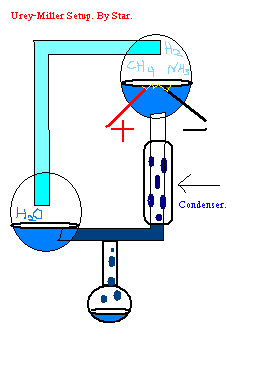
Star - 30-9-2004 at 15:47
How did Life develop?
Very interesting question to anwser with some Biochemistry.
1 Billion Years ago Life was Evolved. Before Life there were Dead' substances on Earth, so how could Life evolve from 'dead' Substance?
How Could Complex Complexes like Nucleic Acids and Proteins form out of the more simple ones that alredy were present before Living' Structures?
There are several competing Theorys about the conditions in the Prebiotic World. One off the Theorys holds that Earths early atmosphere Was rich in
Methane (CH4) Ammonia (NH3) Water (H2O) and hydrogen (H2). The Theory also Holds that this Atmosphere was subjected to large amounts of Solar
Radiation and Lightning.
We shall assume these conditions to be true , be it for sake of argument.
The experiment goes as follows.
A electrical disharge is being passed through the mixture of Methane Ammonia Water and Hydrogen.
A sample is being collected at the end of the cucle for analysis.
Remarkably, the experiment yielded a large quantity of different Organic Molecules, like Amino Acids .
Glycine and Alanine are produced in 2 % yield aprox, depending on the ammount of carbon beying supplied as Methane.Leucine and Glutamic acid are also
produced in Smaller Ammounts.
Worth the try?
What yall say about this experiment?
Is it possible?

The_Davster - 30-9-2004 at 17:44
I would say its worth a try. It should be feasable seeing as this experiment was first sucessfully tried a long time ago with, most likely, crude
equipment, when compared with today's equipment.
In your diagram, the chamber that will have the sparking is suposed to have water vapour, not liquid water.
Also, in the origional experiment, the experimenter(s) had to run the apparatus for days in order to obtain a noticable yield.
BromicAcid - 30-9-2004 at 17:50
Also I remember something about the glassware in the spark chamber being severely attacked and there being high silicate percentages in the products
because of this.
neutrino - 30-9-2004 at 18:13
What could be produced corrosive enought to attack glass like that? Trace amounts of hydrazine hydrate, maybe?
chemoleo - 5-10-2004 at 09:09
Once you do this experiment, what will you do with it? I take it you are hardly in the position to detect trace amino acids, sugars etc? This is
unfortunately the problem of course. But what you can demonstrate at least is that, by starting with a few gasses, and water, you will end up with
some solid compounds... and this by the sheer energy of the spark & the water.
Nonetheless this is a beautiful experiment. This was the first of its kind to demonstrate that, under primordial prebiotic conditions (with a reducing
atmosphere) would produce EXACTLY the compounds we are made of today.
Later experiments by the way changed the setup, by including different types of gases (i.e. HCN, which produced the building blocks of DNA),
phosphates, various ions, silicates, clays (which supposedly may have acted as catalysts).
I think, if you ran this experiemtn on a LARGE scale, like several football pitches large, with various conditions here and there, all somewhat linked
and interacting, with a known set/amount of various chemicals, I am pretty sure, after a few thousand years, one would find some VERY interesting
organic chemicals (I am not saying 'life', just some very exotic unexpeceted organic chemicals).
trace amino acids
Star - 20-10-2004 at 12:03
No, i cant detect the trace amino-acids no. But how hard can it be? Does anyone have information on this?
These solid compounds you are alking about. Which solid compounds do you mean?
Its al about showing that , Only And pure out of the spark and the water, that there can be made More complicated compuonds. Just a insight into how
live could have develloped through time.
You say, that later experiments changed the setup and the compounds used therein.
Maybe with doing this Experimensts, you can change even the latest ingredients' and you'll just see what hapens. You can do the experiment
nder different conditions and with different compunds.
But.. In the end you'll have to be able to see your results? Has anybody got information on tracing Amino-acids?
Yeah, maybe you would indeed have life in the experiment you described.And maybe not.
I think the condictions under which life develloped were more complicated than is beying thought of nowadays.
Danster - 8-3-2013 at 12:35
Dont somebody now please, if there were more experiments made by some other scientists(no Miller or Bada) about this? I am really interested, but i
cannot find anything more than Bada new analysis on Millers samples.
Looking for Life's Origins in the Clouds of a Moon
darel - 11-3-2013 at 13:55
Open with a pdf reader
Attachment: phpohMIin (482kB)
This file has been downloaded 624 times
neptunium - 12-3-2013 at 06:46
the first bacteria/life appeared at the end of the late heavy bombardment (about 3.6 billion years ago) which lead some scientist to beleive the amino
acid and more complex molecules were formed in space and rained down everywhere in the inner solar system during that period. only earth (and maybe
mars at the time ? possibly Venus? ) provided the environment suitable for life to continue its complexity .
the Stanley-Miller experiment is fascinating and was thought out in the 50's as a final nail in the coffin of the spontaneous generation theory.
it is still a theory in progress subject to debate and more evidences are needed but it seems that both phenomenon took place which begs the
question. if it happened all over the solar system , it could have happened arround other stars and given the right conditions life shouldnt be so
rare in the universe!
